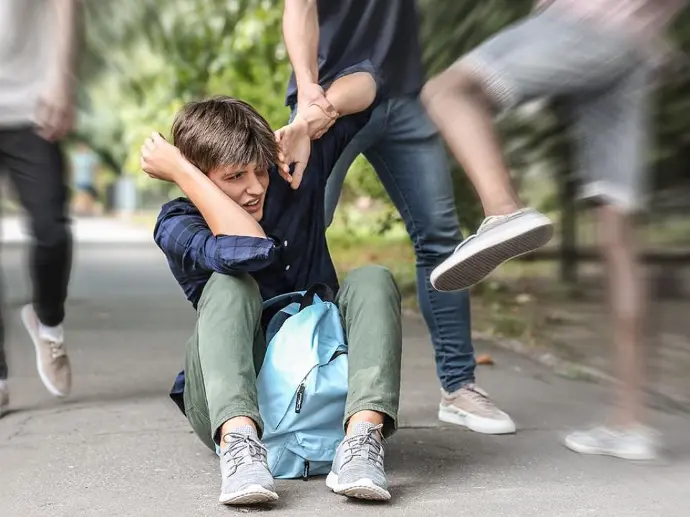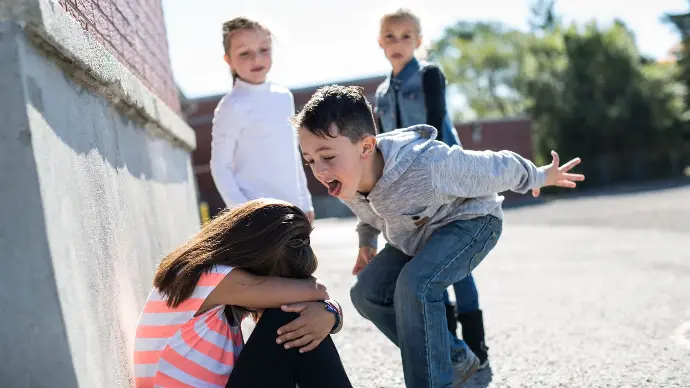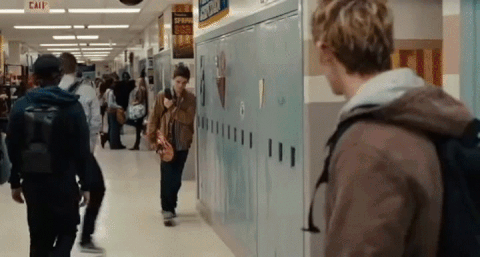
Violence contemplates acts that are carried out with the intention of achieving something through the use of force. Violent behavior, therefore, seeks to physically or mentally harm another person in order to subdue them.

SCHOOL VIOLENCE
There are different types of violence, such as family violence and gender violence. In the case of school violence, it is given by the behavior that develops within a school and that has the purpose of generating some type of damage within said framework.
School violence can develop within the school (in a classroom, a hallway, a playground, etc.) or in other places that are linked to it. Their victims can be students, teachers, school workers or family members of the students.
HOW SCHOOL VIOLENCE DEVELOPS
Within school violence we can emphasize that there are three types that are determined depending on who is the aggressor and who is the attacked. Thus, for example, we can first talk about what violence by students towards other students is. This translates into injuries of various kinds as well as theft of personal belongings, sexual attacks or homicides.
In recent years, this type of violence has given rise to cases known throughout the world in which the victims, "crushed" and humiliated to unsuspected limits, have ended up committing suicide.
Secondly, we find school violence that is exercised by students on the teaching staff of their center in question. It manifests itself both on a physical level, through injuries of different categories, and on a psychological level using insults and humiliations of a wide variety of types. A fact that has unfortunately experienced significant growth in recent years.
And in third place is school violence that is carried out by the teaching staff themselves towards other colleagues, towards students, parents of students or even members of the school who work in the field of administration or services.
School violence is usually associated with bullying or harassment.
DIFFERENT TYPES OF DEMONSTRATIONS
Among the most frequent manifestations of this type of violence are the following:
– Attacks on the emotional aspect of the victims through humiliation or verbal violence in its entirety.
– Physical violence.
– Harmful relationships. This category includes everything from sexual abuse to harassment of various kinds.
CAUSES OF SCHOOL VIOLENCE
There are multiple causes that can lead to the outbreak of school violence. Experts talk about the lack of limits in behavior, the transmission of violent situations through the media that can generate a contagion effect, and the conditions of social exclusion and discrimination.
School violence is frequently associated with bullying, also known as bullying. This harassment consists of subjecting a student to constant and sustained mistreatment over time through teasing, insults, hitting, etc. Schools can be rated according to the risk of violence occurring in their community. The institutions most vulnerable to school violence are those where control is not exercised over their members.
How to solve bullying? 12 wrong thoughts
1 - “These are childish things and nothing happens”
Yes, it happens. And very serious things can happen, such as school suicides directly induced by a bullying situation at school. It is true that children play and sometimes they can cause harm. Getting kicked in a game can be normal. Playing to kick a partner, no. Nor can any form of verbal abuse be accepted, such as repeated insults, or a child never being invited to a birthday by anyone in his or her class.
2 - “It's part of growing up. “Little kids don’t bully.”
Little children do bully. Even at younger ages than you think. It is perfectly possible for a child to be unaware of the damage he does when he repeatedly insults or hits a classmate or takes away his candy. But if this bullying child is not corrected, he will never know, and he will be more likely to repeat that behavior in the future with his parents or his future partner. For harassment to exist, two conditions must be met: that the aggressor is aware of what is being done and that he or she has the intention to cause harm. It must be admitted that a small child who repeatedly attacks another may not know how to gauge the seriousness of his actions. But there is no doubt that he means harm. The educator must stop the latter and take advantage of the opportunity to correct the former.
3 - “Bullying only happens with shy and introverted children.”
There is no specific profile of the victim and the harassed. Also extroverted people or people with friends can suffer some type of bullying. The victim of bullying is defined by one of these two traits:
a) He has a uniqueness that distinguishes him from the rest and that becomes the object of attacks: that he is very smart, not very smart, very short, very tall, that he wears glasses, that his skin color is different...
b) A circumstance occurs that puts him in focus: for example, having missed an important goal in a match, etc. A specific uncorrected aggression can be repeated and prolonged over time until it becomes harassment.
4 - “You don't have to pay attention to harassment: it ends up disappearing on its own.”
At first it doesn't seem important, but if you don't stop it in time it becomes a mass that crushes people. The sooner the educator intervenes, the better. You cannot rely on phrases like “that's life”, “calm down, this will pass with time”, “if they harass you, don't pay attention” or worse, “hit them, defend yourself”. We must ensure that the victim of bullying does not adopt a passive or aggressive attitude, but rather an assertive one: stop the harassment without violence, with the appropriate tools.
5 - “If there are no physical attacks, we cannot talk about harassment.”
Insulting a person, turning them into an object of social contempt or isolating them from the rest of their classmates are drops that, by accumulation, end up destroying the child's confidence. It is proven that the deterioration of self-esteem can generate post-traumatic stress and suicidal tendencies. Years ago it was thought that one could only talk about bullying when a physical attack occurred. Today it is known, thanks to different research, that physical attacks account for only 10% of overall cases of school bullying. Sometimes the psychological consequences of bullying can be worse than the physical ones.
6 - “If it doesn't happen many times, it's not harassment.”
How long is 'many times'? How many attacks must a person endure before they stop being abused? Depending on the criterion, an attack can be considered something specific. Two attacks may perhaps be due to chance. But damage that is inflicted for the third consecutive time implies repetition and an attitude that must be dealt with.
7 - “Bullying has always existed.”
Is it reasonable to allow an evil to persist, or not fight it, because “it has always existed”? Consequences of not avoiding bullying: depression, anxiety, suicide... In addition, children have increasingly easier access to scenes of violence, and they are losing respect for both the figure of the teacher and that of the father or mother themselves.
8 - “The school has done what it should: it has opened the protocol.”
An anti-bullying protocol is very useful... if it prevents it from occurring or if, once it occurs, it contributes to stopping it. But the mere existence and application of a protocol, by itself, does not solve anything.
9 - “My son does not bully: that is impossible.”
No one behaves at home as naturally as they do at work. Neither do the children. To reverse this situation, he recommends that overprotective parents attend a juvenile court as an audience, to see with their own eyes what a child who has not been corrected in time can become. Sometimes, the school complies with all the required steps to avoid bullying and it is the parents who prevent their child from receiving an educational punishment, such as arriving at school an hour early or cleaning the classroom. It is essential that parents support the sanctions, not punitive but educational, that are applied to their children when they have harassed a classmate.
10 - “How have I not realized that my son is being bullied?”
All harassment sends signals that can be perceived in the environment of the person who suffers it, as long as due attention is paid. Parents should be attentive to signs that may indicate that something is not right: the child is afraid, sleeps poorly, frequently loses school supplies, arrives with scratches or scars, wakes up with vomiting, dizziness or fatigue... To a parent who If you are surprised to find out that your child is being bullied, you have to ask: do you know your child well?
11 - “Nothing can be done against harassers because there is no criminal sanction against them.”
That a child does not have criminal responsibility does not mean that he does not have the right to be corrected. If you have to punish him to re-educate him, the appropriate punishment must be applied to correct his mistakes. The child who bullies has a responsibility and must understand that her bad behavior has negative consequences for him.
12 - “When faced with bullying, the best thing is to change the victim's school and expel the person causing the bullying.”
Neither one nor the other. Starting from the end, expulsion from school as punishment for bullying can be counterproductive. The child may interpret being without classes as a wonderful benefit. He doesn't have to get up early and on top of that, when he is left alone at home, he can have free time to play whatever he wants. So when the punishment ends, he is more likely to repeat his bullying behavior to cause another expulsion.

 IHRO NEWS
IHRO NEWS
